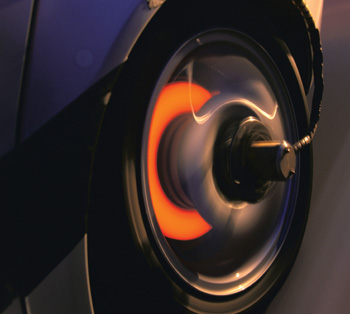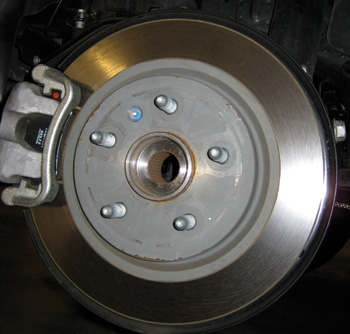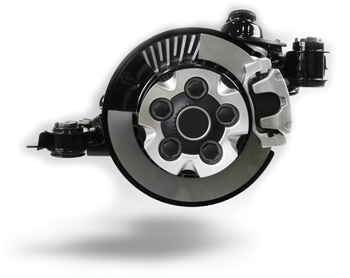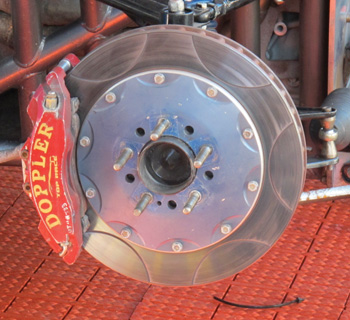 When you compare the rotors side-by-side, they may look the same. But, the difference between a comeback and satisfied customer might be at the microscopic level.
When you compare the rotors side-by-side, they may look the same. But, the difference between a comeback and satisfied customer might be at the microscopic level.
Just about every rotor is made of cast iron. But, what can make or break a rotor are ingredients like carbon, chromium silica and pearlite. Also, how a rotor is cast and cooled can determine its final properties. This is called the science of metallurgy.
Ensuring that a rotor has the right metallurgy costs the manufacturer time and money. It is not that the raw material costs more, it is that the manufacturing process may require more expensive equipment. Also, increasing energy costs and labor costs may be higher.
You may be saying, “iron is iron.” This is not true when it comes to brake rotors. OEMs use different grades of iron to ensure that a vehicle platform has the right characteristics of wear, noise dampening and performance. Like brake pads, rotors can be vehicle specific.
 Taking a chance with some “cheap,” “economy” or “inexpensive” rotors that do not use the right grade of iron or manufacturing process could end up in a comeback.
Taking a chance with some “cheap,” “economy” or “inexpensive” rotors that do not use the right grade of iron or manufacturing process could end up in a comeback.
Microstructures
Talk to any metallurgist or materials engineer and they will inevitably mention microstructures. What they are talking about is how the atoms and molecules bond or connect with each other to form small cohesive structures.
Think of these microstructures as a tiny racecar roll cage. A strong roll cage joins to the chassis at many points and the bars intersect at many joints. However, a weak roll cage will have fewer bars and joints. The stronger roll cage is able to resist being torn apart because it has more connections and stronger bonds. Also, a well-designed roll cage can influence the overall performance of the vehicle.
The same can be said about the cast iron mix that makes up a rotor. How the iron interacts with other elements like graphite (a form of carbon), silica and other materials can influence the microstructure of the iron and influence the final product. These microstructures can influence properties like wear, coefficient of friction and noise control.
Metallurgists can fine-tune the mix of iron and element to give a rotor the right characteristics for a vehicle. If more graphite is added to a mix, it can improve the noise damping properties of the rotor. But, the increased graphite content can lower the rotor’s resistance to wear and abrasion. If the wear characteristics need to be improved, a substance called pearlite can be added to the mix.
Achieving the best performance of the rotor is a balancing act. Adding too much of a component can ultimately affect the rotor’s ability to generate friction and dissipate heat.
Did You Know…
To be able to sell you a low-priced rotor, it takes more than the cheap labor and relaxed environmental standards of a third world country. To be the least expensive rotor, the cost cuts come at the expense of metallurgy.
However, not all rotors from overseas have incorrect metallurgy. In fact, some of the best casting comes from overseas. It is up to you to investigate brands and reputations.
Stressing Out
Casting rotors can stress them out. Going from cold raw material to a hot liquid, then cooling into a new shape causes stress in the raw casting.
The microstructure of the rotor contracts as it cools. If one area of the rotor cools faster then an adjoining area, stress is created between the two areas due to the different rates of contraction. As you can imagine, rotors with large hats or a large swept area have areas that cool at different rates.
This stress can influence the performance of the rotor under heat and mechanical forces. This includes warping and mechanical failure. In other words, this stress could cause you the stress of a comeback in some cases.
To avoid these problems for some applications, a reputable rotor manufacturer will perform a process called stress relieving. It is a process where the fresh cast rotor is kept at a constant temperature for a certain length of time. Stress relieving is typically performed in the temperature range of 500°C and 650°C for periods up to 24 hours. This can cost a brake rotor manufacturer time and energy costs.
Stress relieving of cast iron rotors can be performed to minimize rotor warping or thickness variation that can occur under extreme service conditions. Stress relieving has no effect on microstructure. While it may not be required for every aftermarket rotor, for some applications it is critical.
 Some people in the aftermarket believe that stress relieving can be taken one step further by cooling the rotor with liquid nitrogen, commonly known as cryogenically freezing. This process is similar to stress relieving, but instead of using a high temperature, it cools the rotor to -300º Celsius to relieve stress and improve the microstructure, according to companies that perform this service.
Some people in the aftermarket believe that stress relieving can be taken one step further by cooling the rotor with liquid nitrogen, commonly known as cryogenically freezing. This process is similar to stress relieving, but instead of using a high temperature, it cools the rotor to -300º Celsius to relieve stress and improve the microstructure, according to companies that perform this service.
This process was once used only on exotic racecars, but many municipal fleets of ambulances and police interceptors are using cryogenically treated rotors to cut replacement costs.
Cold Snap
One way to make sure the metallurgy of a rotor is the best it can be is to cryogenically treat the rotor after it has been manufactured. Cryogenic processing involves placing rotors in special refrigeration equipment that takes the parts down to the temperature of liquid nitrogen — minus 300° F below zero! At such extremely cold temperatures, a lot of really “cool” things happen.
Atoms stop shaking around and settle down into a more relaxed state. This helps relax residual stresses in the metal for improved fatigue resistance, tensile strength, abrasion resistance and hardness.
In steel alloys, it can actually change the microstructure of the metal itself. Cast iron contains more carbon than steel, so the microstructure does not change as dramatically.
Even so, when done properly, a cryogenically treated rotor will run cooler (some claim up to 40% cooler!), last longer (two to four times longer), and resist warping and cracking better than any untreated rotor. The process can be applied to stock OE rotors, aftermarket rotors, or drilled or slotted rotors, and it treats the part all the way through, not just the surface.
Racers often have engine and chassis parts cryogenically treated to improve their durability so they don’t break during a race. The same process is also used to improve the life of tool bits, gun barrels, razor blades, knives, and even golf clubs and baseball bats.
The science of cryogenics dates back to the 1930s, when the Germans invented it for treating critical parts that went into aircraft engines. It wasn’t until the 1960s, however, that cryogenic processes were developed in this country for treating automotive and industrial parts.
The process is sort of like heat-treating in reverse. The temperature of the object being treated is changed to bring about improvements in its crystal structure. Cryogenics requires freezing parts at a controlled rate so they don’t get too cold too quickly and shatter.
If you drop a rubber ball in a tank of liquid nitrogen, it will become as brittle as glass, and the ball will shatter if it’s dropped on the ground. But if the ball is allowed to warm back up, it will not only bounce the same as before, but also bounce longer and better.
Once parts are cooled down to minus 300° below zero, they’re cold soaked for a number of hours before they’re allowed to gradually warm back up to room temperature. The process is computer controlled and may take 36 to 74 hours, depending on the mass and type of parts being treated.
Those who use cryogenically treated rotors say they can be resurfaced the same way as regular rotors, and used until they wear down to minimum thickness specifications. No change in friction materials is required, though some rotor suppliers recommend using semi-metallic pads for best results.
—————————————-
FYI — Follow-up from author Andrew Markel
When addressing this issue, there is no real way to tell if a part has been treated. This is why it is so controversial. But, some racing teams and fleets swear by it.
For more information, check out Frozen Rotors — one of the biggest names in the cryogenics field:
http://www.frozenrotors.com/
contact — Bill Groschen [email protected]
They are part of Diversified Cryogenics www.diversifiedcryogenics.com.











